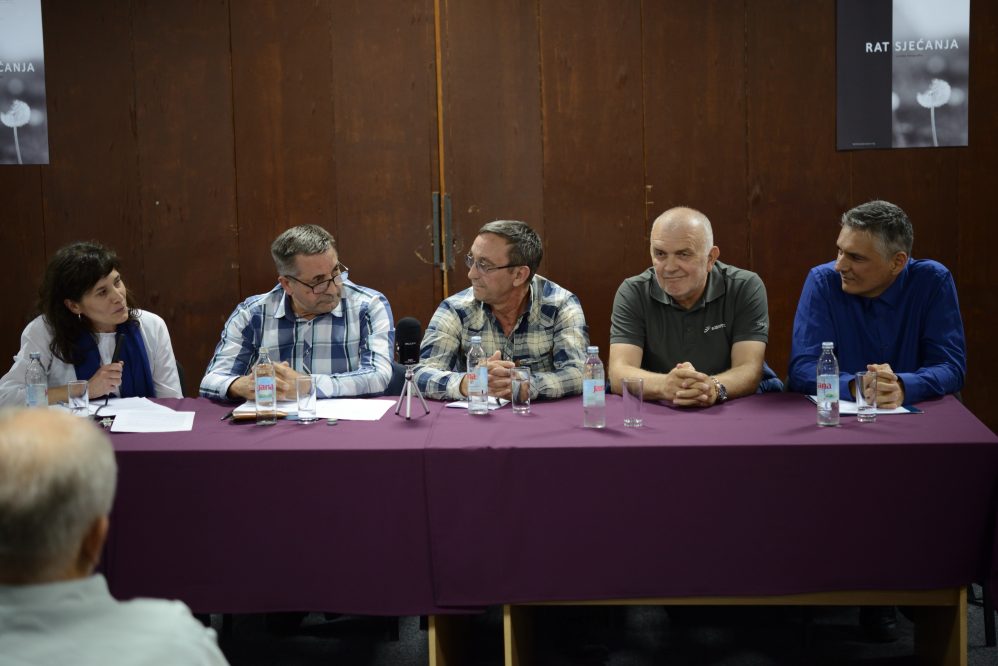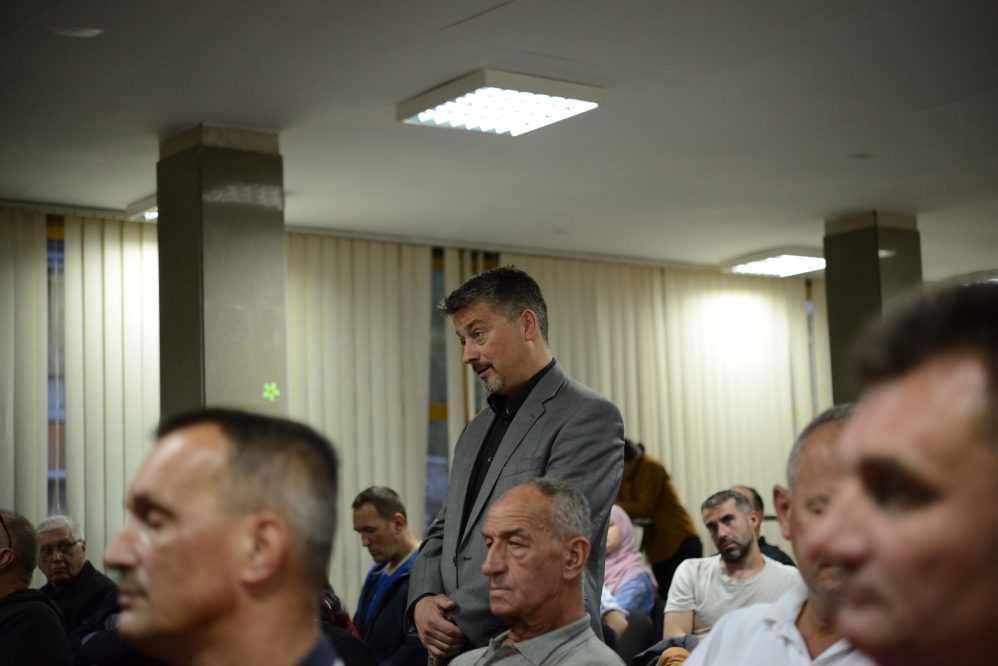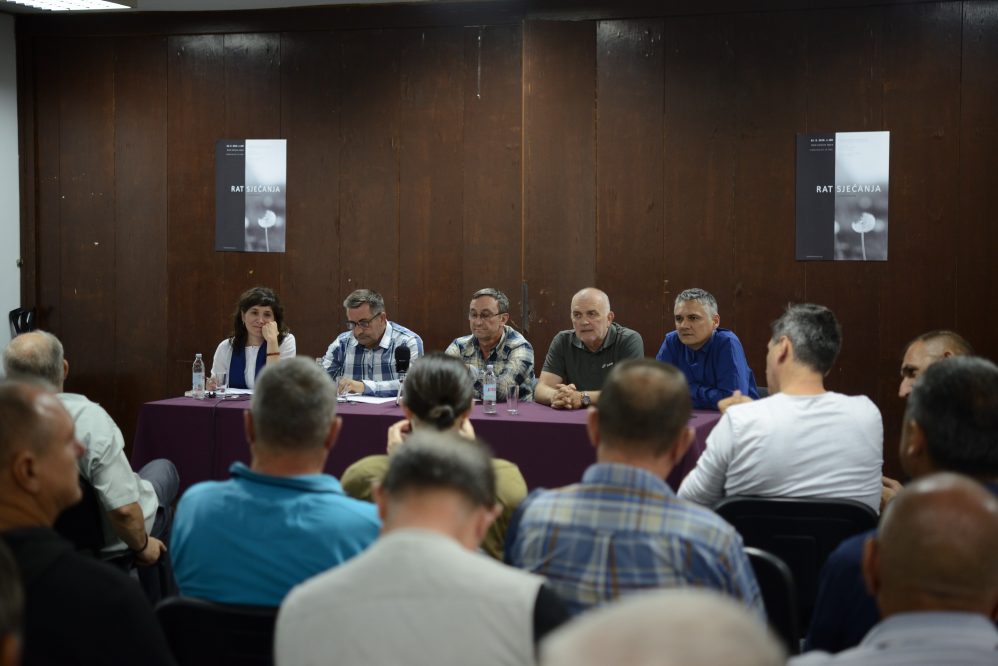Organised by the Centre for Nonviolent Action Sarajevo/Belgrade, with the support of the Jajce Culture Centre and the Veterans’ Association, the photography exhibition “War of Memories” by Nenad Vukosavljević and Nedžad Horozović was opened on Monday, 23 September 2019.
At the opening of the exhibition, we continued our practice started in Goražde and organised a public discussion titled “From a War of Memories to Remembering the War” and this time subtitled “Fighters in War and Peace”. War veterans from different armies who have since become dedicated to peacebuilding: Stanislav Krezić from Mostar, veteran of the Croat Defence Council (HVO); Novica Kostić from Vlasotinac, veteran of the Yugoslav National Army (JNA), Nazif Kahrić from Jajce, veteran of the Army of the Republic of Bosnia and Herzegovina (ARBIH) were joined at the discussion by CNA activists Nenad Vukosavljević from Belgrade and Davorka Turk from Zagreb.
How important is it to honour all victims of war in order to rebuild trust and how should this be done? How often does personal experience of having participated in war feature as motivation to engage in peacebuilding work? How important is it individually for war veterans to honour the victims on other sides? How do their communities react to their activism? These are just some of the questions the discussion participants tackled. Referring primarily to their own engagement in visits by mixed groups of war veterans to sites of suffering, the veterans spoke from a personal point of view about their motives and the reasons for joining these actions, as well as the importance of involving war veterans in peacebuilding processes.
The Speaker of the Jajce Municipal Council, Ivo Šimunović, attended the opening of the exhibition and welcomed everyone at the start of the discussion.

Novica Kostić from Vlasotinac, Serbia, has been involved in the work of CNA from the very beginning. He found motivation to join the actions and still draws it from his personal war experiences: “The images of war that are etched deeply in the memories of anyone who was there are motivation enough to work on making sure such evil never happens again to anyone.” The questions he would ask himself: What for? Why? What am I personally guilty of in all this? What is my personal responsibility? And what about the other side? These questions created the desire to talk to people on the other side and provided the motivation to continue working on peacebuilding.
“If we were the first to take up arms, we can also be the first to start peacebuilding actions,” Stana Krezić from Mostar said. Nazif Kahrić from Jajce finds motivation for peacebuilding in his desire to “help those in need and express his condolences to those who do not belong to my people.”
Our perception of war, of how we remember war, is also shaped by the education system, the media, religious communities, official policies, etc. However, war veterans can and do have a significant influence because they are a group of people that enjoy a high degree of credibility when it comes to discussing what they experienced first-hand.
Nenad Vukosavljević from the CNA team talked about the importance of involving war veterans in processes of constructive dealing with the past and peacebuilding and about how the idea for peace activists to work with war veterans came about: “The need to rehumanise the enemy, to restore to them their humanity, to effect normalisation and evolve from a state where the threshold of violence was so low, this need, felt keenly by veterans, is one of the reasons behind their joining peacebuilding processes.”
Opening the exhibition as one of its authors, Nenad Vukosavljević linked working with war veterans and the photographs from “War of Memories” as two things that deal with the same issue:
“The exhibition reminds us of an irrevocable loss. Nothing can bring back lost lives, but we can do something to give that loss meaning. This exhibition is an attempt to provide meaning. It is a struggle for the future, because the threat of relapsing into war can be averted precisely through the memories we construct. War veterans provide an example of how to do this. Through peacebuilding.”

The “War of Memories” exhibition is part of the project “War Monuments in Bosnia and Herzegovina”. These are photographs of marked and unmarked sites of suffering in Bosnia and Herzegovina made in order to research, document and analyse the memorialisation policy and culture of memory that arose after the last war, primarily viewed from the perspective of building lasting peace. Why and how do we remember war? What kinds of monuments do we construct? What is the culture of memory about the wars from the 1990s in Bosnia and Herzegovina and the region? The exhibition and research seek to initiate dialogue about current forms of memorialisation and enable constructive opportunities for change.
Since its inauguration in Sarajevo in 2016, the exhibition has been displayed in 13 cities – in Mostar, Banja Luka, Bihać, Belgrade, Tuzla, Brčko, Novi Pazar, Kragujevac, Skopje, Vienna, Zavidovići, Podgorica and Goražde – and it will remain on display for the citizens of Jajce at the Culture Centre until 4 October 2019.
The research study and photographs are available online at www.kulturasjecanja.org.
We are glad that the public discussion and exhibition were covered by many media outlets, because they also have significant influence over and responsibility for creating memory policies and for constructing and shaping cultures of memory. It was encouraging to see TV news crews from Croatia, Montenegro and Bosnia and Herzegovina, as well as many reporters from the region.
We are encouraged that open discussions about war, about how we remember it, what still grieves us both as individuals and as societies to this day, twenty years later, what bothers us and what our memories have in common, what we would like to change, that these issues are gaining more and more media support. Examples showing that a different path is possible for cultures of memory will be distributed by the media across the region and hopefully move people to action.
